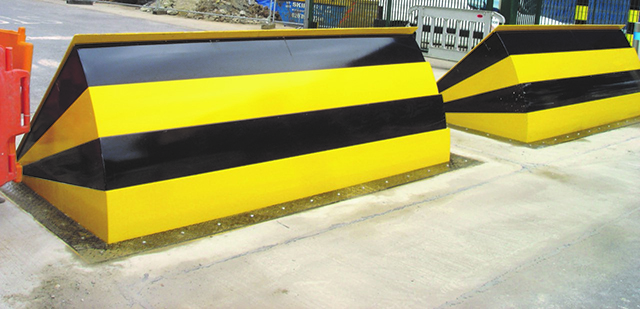Wedge Barriers Things To Know Before You Get This
Wiki Article
The Ultimate Guide To Wedge Barriers

Some Known Questions About Wedge Barriers.
g., spring support 65 )may be repaired to completion of the springtime pole 58 to make it possible for compression of the springtimes 60. As the springtimes 60 are pressed in between the spring sustains 62, the spring setting up 54 creates a force acting upon the web cam paired to the springtime pole 58 in an instructions 66. For instance, the remaining pressure related to the camera to deploy the wedge plate 16 might be provided by an electromechanical actuator 84 or various other actuator. The spring setting up 54 and the actuator 84(e. g., electromechanical actuator)might run with each other to equate the cam and lift the wedge plate 16.
As pointed out above, the springtime setting up 54 applies a constant force on the web cam, while the electromechanical actuator might be regulated to apply a variable pressure on the webcam, thereby enabling the lifting and decreasing( i. e., releasing and retracting )of the wedge plate 16. In certain embodiments, the constant pressure applied by the springtime assembly 54 may be adjustable. g., electromechanical actuator) is handicapped. As will certainly be appreciated, the springtime setting up 54 might be covered and shielded from particles or various other aspects by a cover plate(e. g., cover plate 68 received FIG. 4) that might be significantly flush with the raised surface 38 of the structure 14. As discussed above, in the released placement, the wedge plate 16 offers to block accessibility or travel beyond the barrier 10. The obstacle 10(e. have a peek at this website g., the wedge plate 16 )may block pedestrians or automobiles from accessing a home or path. As gone over over, the Resources obstacle 10 is attached to the support 30 secured within the structure 14,

front braces 71. Consequently, the linkage assemblies 72 may pivot and turn to allow the collapse and expansion of the affiliation settings up 72 during retraction and release of the bather 10. The link assemblies 72 reason movement of the wedge plate 16 to be restricted. For example, if a lorry is traveling in the direction of the released wedge plate 16(e. For example, in one circumstance, the security legs 86 might be extended duringupkeep of the obstacle 10. When the security legs 86 are released, the safety and security legs 86 sustain the weight of the wedge plate 16 versus the surface 12. Consequently, the training mechanism 50 may be deactivated, serviced, gotten rid of, replaced, and so forth. FIG. 5 is partial viewpoint view of an embodiment of the surface-mounted wedge-style obstacle 10, showing the camera 80 and the webcam surface areas 82 of the lifting system 50. Especially, 2 camera surfaces 82, which are referred to as lower webcam surface areas 83, are placed listed below the webcam 80. The reduced web cam surface areas 83 might be taken care of to the surface area 12 (e. For instance, the lower camera surface areas 83 and the placing plate 85 may form a solitary piece that is safeguarded to the support 30 by screws or various other mechanical bolts. In addition, two web cam surfaces 82, which are described as upper cam surfaces 87, are positioned above the camera 80 and combined to (e. In various other embodiments, stepping in layers or plates may be placed between the surface 12 and the reduced camera surfaces 83 and/or the wedge plate 16 and the upper webcam surfaces 87 As stated above, the cam 80 converts along the webcam surface areas 82 when the wedge plate 16 is raised from the withdrawed setting visit the site to the deployed placement. In addition, as pointed out over, the spring setting up 54 (see FIG. 3 )may offer a pressure acting on the camera 80 in the direction 102 using springtime pole 58, which might minimize the pressure the electromechanical actuator 84 is needed to apply to the webcam 80 in order to actuate and lift the wedge plate 16. 1 )to the released placement(see FIG. 4). As shown, the cam 80 consists of track wheels 104(e. g., rollers), which contact and convert along the cam surface areas 82 during procedure.
Report this wiki page